Menus
- The Z super Roadster version !
- Discovery
- R for Rigor Adjustment….
- A little more "Racing"
- Improved feeling
- Conclusion
The Z super Roadster version !
There are emblematic models by their distribution, the commercial enthusiasm they arouse.
The Z 750 is in this vein. With nearly 6,000 sales in 2010 in France and 45,000 copies sold in France, all vintages combined, since its launch in 2004, the 750 Kawasaki roadster is a UFO that continues to dominate the heads of sales and especially those roadsters. Kawasaki is the first to have increased the range of wicked roadsters from 600 to 750 cc … a displacement that brings more sensations while keeping a form of ease of handling: the best ratio between 600 and 1000 ?
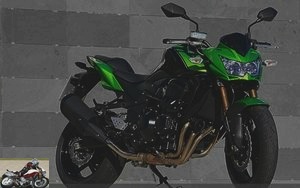
With the Z750R, Akashi’s green men wished on the strength of this success to reinforce the Z concept to the end by offering an "ultimate" version, more racy. Because the trend is for Rageuse, Racing but also Shiny.
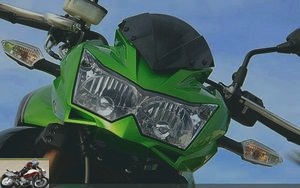
In the same segment, there is now in addition to the standard version, a high-end offer, with a more richly equipped, more successful model. And that’s pretty welcome. Because if the Z occupies first place in sales, the comparisons point to its perfectible handling and its lack of liveliness in the face of the competition. To have a good face is good! But barking doesn’t stop the caravan of competition from passing. This development is perhaps also (or above all?) Put in place to face an organized competition: Suzuki GSR 750, Honda Hornet 600, Ducati Mostro 796 but particularly the Triumph Street Triple R.
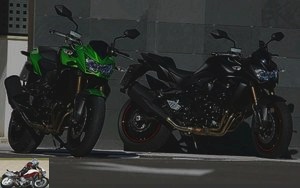
By offering on the market a machine that is even more fun and above all better equipped for a limited budget, Kawa hopes to attract even more fans of “nasty” roadsters and continue to win not only sales but also comparisons. To stand out from the band, it will now be necessary to be the leader …. the king. Successful bet ?
Discovery
Aesthetically, we will note two new colors: a two-tone black and green varnished paint, or a plain matt black paint. The first particularly emphasizes the Z lines and the sporty aspect. The optical unit is also modified, offering a more aggressive plastic. The dashboard does not change but the rev counter receives a black dial background and the initials R.
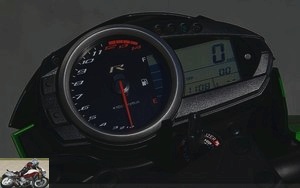
The list of minor changes also includes: new 3-piece front fender, reworked chain guard, handlebar grips borrowed from the sporty 2010 ZX-10 R, mirror stems, redesigned turn signal shapes, new footrests and treatment engine surface (matte black on some parts). So much for the style !
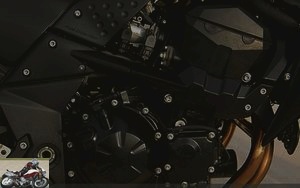
But the profound changes made to this Z mainly concern the cycle part and are organized around 3 axes: suspensions, braking, rigidity.
Indeed we quickly notice the pretty inverted fork 41 mm in diameter, with light gold sheaths, from the Z 1000 vintage 2009 and now adjustable in rebound on the two tubes. The preload adjustable shock absorber gains a separate larger capacity cylinder to improve operating efficiency. The bonuses stop there on this element…. A priori, we do not have all the possible and imaginable settings in the same way as a sportswoman for example.
Let’s move on to the brakes. And, here it is: in the front, 4 piston radial calipers, radial master cylinder and, finally !, aviation type hoses made of good braided metal fibers. Ditto for the rear where the master cylinder, which has also become radial, has its diameter reduced from 14 to 12.6 mm in order to compensate for the feeling at the foot.
The thickness of the discs is also increased by 0.5 mm. The whole thing is a direct appeal to sports pilots eyeing the circuit.

Another point is that the front wheel axle has been widened to strengthen it. Tire fitting abandons the Dunlop Qualifier for D 210, a supersport tire developed to equip the Kawasaki Z1000 2010 model year as original equipment as well as the Yamaha YZF R1. The pretensions of the model are indeed Sport !
Finally, the R gets rid of its very classic steel swingarm for a cast aluminum element, much more elegant. Kawasaki also announces an overall weight gain of 3 kg over the entire bike.
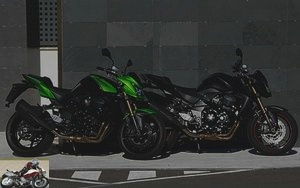
In short, the green brand seems to have taken the measure of the few shortcomings of the classic Z and done everything to remedy them. The roads of the Alicante region will now serve as a justice of the peace to determine the real benefits of so many changes.
R for Rigor Adjustment….
On board, nothing new, the position is always tilted slightly forward and resting on the large right handlebars, rather sporty but not excessively. Although imposing, the Z 750 R version remains as accessible as ever and imposes its stature as a sporty roadster. That’s good. The south of Spain is well endowed with small winding roads, ideal for testing cycle parts.
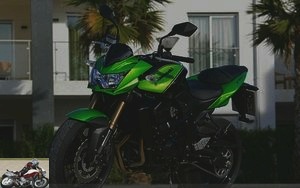
The flexible controls and the precise and smooth gearbox remain a real advantage. The front axle is reporting the information well, helped by the new tires. In town, the flexibility of the engine allows changes in 6 ° from 30 km / h. And it reacts immediately. The sporty roadster can be tamed to also allow easy daily use.
The first kilometers are done on expressways with excellent asphalt, unfortunately wet. The R is pleasant and docile, especially at a steady pace.
There are even the familiar vibrations at the approach of 7,000 revs, or 140 km / h, at the level of the tank and the saddle, which the new all-metal toe clips transmit even better to the feet. Despite everything, we take pleasure in winding the controls of the large handlebars but also in attacking very quickly with largely prohibited speeds..
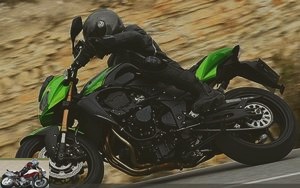
However, the handling needs to be kept clean because the Z still doesn’t really like line changes and corner braking. It then stiffens and significantly widens the trajectory.
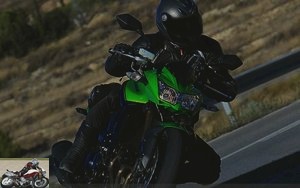
Available from 4,000 revolutions / minute, the Kawa block really begins to sing after 7,000 revolutions. And we like to make the engine roar with a very fast, really very fast pace. It is therefore necessary to pay attention to degraded roads which can undermine the confidence quickly obtained..
The spring damping is barely more progressive than that of the classic version. Bumps and compressions are still handled dryly and emphasize the saddle’s rather slim comfort. The disagreement with the fork is also felt. We can (and must) then stop to adjust the trigger, by default too open.
A little more "Racing"
The hydraulics once more braked, things are improving. The Z750R then becomes more rigorous. The fork rises less quickly, allowing rapid changes of angles and go-arounds which somewhat limit the jolts and unwelcome ripples in sporty driving seen before setting changes. We would have liked an even more incisive behavior that the new suspensions do not clearly reveal.
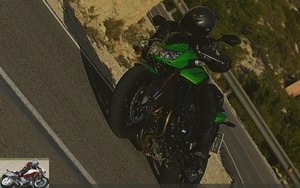
Without being a model of agility, the R version allows you to go at a good pace in the winding. Akashi’s 4-cylinder engine is very pleasant there, and even more so in second or third gear, between 6,000 and 10,000 rpm.
Improved feeling
That’s when you appreciate the evolution of the brakes. The classic model is not bad on this point, but now rear and front offer a better feeling. Although firmer, the retarder controls provide progressive but powerful braking. This will reassure the less seasoned and will finally allow the more comfortable to get on the circuit efficiently, the aviation hoses providing the endurance necessary for use on the track. Finally, the more cautious will opt for the ABS option.
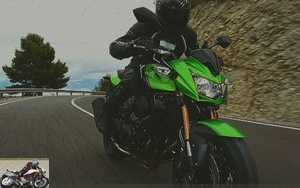
Conclusion
Always more enticing and rebellious in look, better equipped, this evolution of Kawasaki’s star roadster reduces the faults of this model. The brakes constitute the biggest evolution and the strong point of this R with a very clear gain in performance and endurance, well supported by an adjustable fork which brings more precision. This justifies the additional 900 euros required to acquire it. However, its once extremely attractive displacement / price ratio is being undermined..
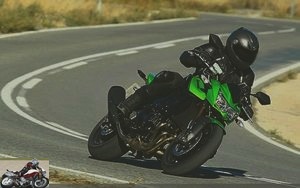
At € 8,599 (€ 7,699 for the classic Z 750) and € 9,199 for the R – ABS version, the Z certainly gives more, both in terms of aesthetics and quality of equipment, but is now almost at the same price as a Street Triple R. If these do not make a big difference in dynamics, they still allow you to go further on your handlebars, especially on the track.
However, the Z 750 R remains a heavy motorcycle (224 kg all full) with performance geometry below its main designated rival, the Triumph Street Triple R (189 kg; on the same segment for € 8,790). It will also have to deal with the announced arrival of the Yamaha FZ8R…
Kawasaki expects 40% of R models delivered out of the total sales of its Z 750 roadster. It’s probably its naughty look and more imposing appearance that will once again win over future owners. The possibility for them to step out of the ranks of the many unretouched models and ensure a better resale rating by signing today for an R … and while waiting for a real new Z.
Strong points
- Look
- Dynamic behavior
- Front brake
Weak points
- Aging geometry
- Comfort
Available in: black, gray, green
Model tests: Z 750 N,
Z 750 S
Competitors: Ducati Monster 796, Honda Hornet 600, Suzuki GSR 750, Triumph Speed Four, Triumph Speed Triple, Yamaha
Fazer 600
Comparative technical sheet
of the Kawasaki Z 750
Related articles
-
Triumph Speed Triple R 1050 motorcycle test
A top-class Speed Triple From the luxury spokes from Ohlins for the suspensions, Brembo for the monobloc calipers and PVM for the forged wheels, the…
-
BMW R 1200 R Classic motorcycle test
Retro kaiserin for modern fun 1923: BMW markets its first R 32s … This 18th letter of the alphabet will henceforth be used to name the machines powered…
-
Evolution or revolution of the ER6-f with the in-line twin of 649 cm3, 68 horsepower for 193 kilos A more sporty look but, paradoxically, a gain in…
-
2012 Kawasaki ER-6f motorcycle test
Swiss army knife first price While the ER-6n has been a historic bestseller in the Kawasaki lineup since its debut in 2006, its streamlined “f” version…
-
Ducati Monster motorcycle test
Salon revolution V-Twin Testastretta of 937 cm3, 111 hp, 93 Nm, 166 kg dry (188 kg full made), 11,290 euros Is a Monster still a Monster if it doesn’t…
-
Kawasaki Z H2 Supercharged motorcycle test
200 hp, 14 mkg at 8,500 rpm, 239 kg all full, 17,099 € Put some salt ! Fifteen days of driving with the Kawasaki Z H2? I say it bluntly, it takes less to…
-
Ducati Monster 620 motorcycle test
Biker testing: Garfield Ducati and me, it’s a long platonic love story. Between in high school in the late 80s, the teenager I was did not fail to swoon…
-
Triumph Speed Triple 1050 motorcycle test
Rebel gentleman ! Since its creation, the Speed Triple has taken the classic aesthetic codes of THE virile motorcycle. In 1994, the English brand…
-
2012 Kawasaki ER-6n motorcycle test
New test: Kawasaki ER 6N: Sparkling with mischief ! Appeared in 2006 and restyled in 2009, the ER6 N gets a new facelift that makes it even sexier,…
-
Ducati Hypermotard 950 and SP motorcycle comparison test
The art of irreverence L-Twin of 937 cm3, 114 hp and 9.8 mkg, 200 kg full made, from 12,690 euros What is a Hypermot ‘? If we say it’s a mix of supermot…